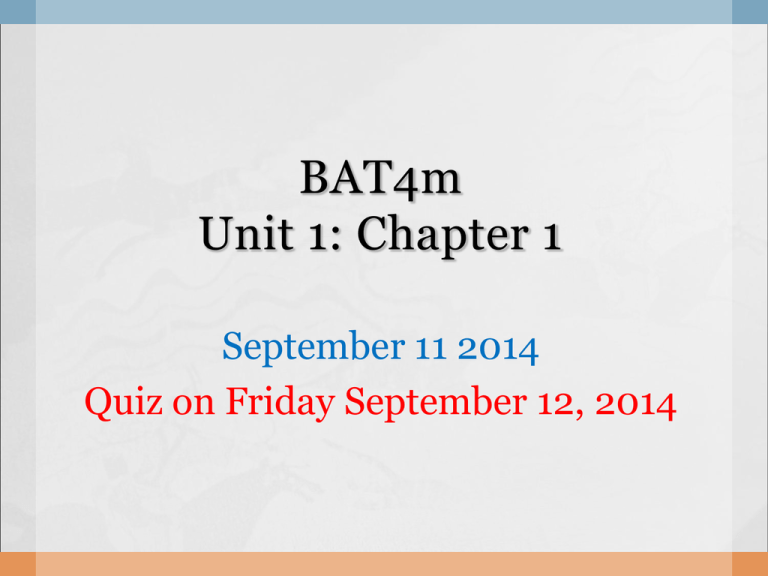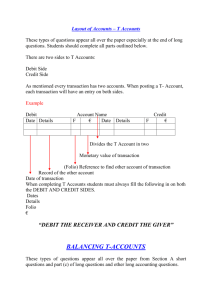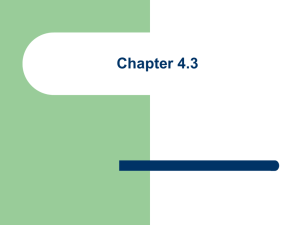September 11 Chapter 1 BAT4M
advertisement

BAT4m Unit 1: Chapter 1 September 11 2014 Quiz on Friday September 12, 2014 The Simple Ledger • An ACCOUNT is a specially ruled page designed to record the changes in each individual item affecting the financial position • Business transactions (we learned in unit 1) are recorded in General Journal first and then the numbers will be transferred to each account. • Usually there is one account for each asset or each liability. Simple Ledger The T-accounts (or General Ledger pages) are kept in the order in which the items are found on the balance sheet. At the front of the ledger there is a Chart of Accounts (like table of contents of a book) which lists all the account names and account numbers. NOTE: Asset accounts usually start with a “1”; Liabilities accounts usually start with a “2” & Owner’s Equity accounts usually starts with a “3” The Simple Ledger • LEDGER is a group of accounts • Ledger is like a book or computer file • Ledger is a permanent summary of all transactions. • A company's financial statements are generated from summary totals in the ledgers (Just as the ending balance of Equation Analysis Sheet was used to make Balance Sheet.) The Simple Ledger • A book that has a separate page for each account (item found on the B/S) and has each transaction recorded in it is called a GENERAL LEDGER • T-Account: Simple type of account. This is used to help you understand accounting theory. Account Name Left Right Four important features of all ledger accounts (or T accounts): 1. Each individual balance sheet item (such as cash) is given its own page (space) with the name of the item at the top. These individual sheets are called accounts. 2. The dollar figure of each item is recorded in the account on the first line Assets Beginning $ Value Debit and Credit Theory As we learned in chapter 1, every transaction must affect the accounting equation min twice! Every account has two sides and they are referred to as the Left Side (Debit) and the Right side (Credit). The two sides allow the accountant to show an increase or a decrease in its amount. T- Accounts Left Side Right Side (Debit) (Credit) Dr. Cr. Debit Credit Accounting Rap song by Colin Dodd http://www.youtube.com/watch?v=j71Km xv7smk High School - Accounting Rap The Rule of Debit and Credit • Increases are shown on the same side as normal beginning balance of the account appears in the equation • Decreases are shown on the opposite side • For example, for cash account, when the transaction increase the balance, the amount should be recorded in the left side (debit) of the T account. The Rule of Debit and Credit • Increases are shown on the same side as normal beginning balance of the account appears in the equation • Decreases are shown on the opposite side A = Assets Debit Credit L + OE Liabilities Owner’s Equity Debit Debit Credit Credit The Rule of Debit and Credit • Increases are shown on the same side as normal beginning balance of the account appears in the equation • Decreases are shown on the opposite side A = Expense Debit Credit L + OE Revenue Debit Debit Credit Credit Double Entry System of Accounting Every transaction in business is recorded both as a debit in one or more accounts and as a credit in one or more accounts. Under this system, the total of the debit entries equals the total of the credit entries Steps in the Recording Process 1. 2. 3. Source Document – Analyze each transaction for its effects on the accounts. Enter the transaction information in a journal (book of original entry) Transfer (post) the journal information to the correct accounts in the ledger (book of accounts) Class work / Homework P82 E2-3, E2-5, E2-6 P85 P2-2A, P2-3A (tomorrow’s HW)




